HMS Queen Elizabeth left dry-dock at Rosyth today after undergoing critical repairs to her starboard propeller shaft coupling and is now back at Sea.
This technical issue had previously forced the ship to withdraw from the NATO exercise Steadfast Defender, resulting in HMS Prince of Wales taking her place.
However, this early docking has allowed work scheduled for her upcoming redif to be completed earlier than planned.
A Royal Navy spokesperson told me :
“HMS Queen Elizabeth has completed her defect repair work and capability upgrades at Rosyth and will now undergo a period of sea trials to prepare for future tasking.”
The vessel will remain at anchor before heading out into the North Sea.
One of the most powerful surface warships ever constructed in the UK, HMS Queen Elizabeth forms part of the Royal Navy‘s two-strong fleet of Queen Elizabeth Class aircraft carriers.
On their website, the Royal Navy say that “HMS Queen Elizabeth is an investment in Britain’s security, prosperity and place in the world. She will provide a conspicuous presence on the global stage, sending a clear message of reassurance to our allies, and of defiance to those who would do us harm”.
The development of the Queen Elizabeth class began in the late 1990s. The Strategic Defence Review (SDR), initiated by the Labour government in 1997, aimed to reassess the UK’s defence strategy. Published in July 1998, the SDR highlighted the strategic importance of aircraft carriers for offensive air operations, particularly in scenarios where foreign bases might not be available.
The review recommended replacing the ageing Invincible-class carriers with two larger vessels, envisaging ships of around 30,000 to 40,000 tonnes capable of deploying up to 50 aircraft, including helicopters. Initial design studies started in the mid-1990s, exploring options such as extending existing hulls, converting commercial ships, and building new purpose-built carriers. By 1999, two consortia led by BAE Systems and Thales Group were awarded detailed assessment contracts.
The design process advanced significantly by 2006, leading to the announcement of the contract in July 2007. Formal signing occurred on 3 July 2008, involving the Aircraft Carrier Alliance, a partnership of Babcock International, Thales Group, A&P Group, the UK Ministry of Defence, and BAE Systems.
The construction of the Queen Elizabeth-class carriers faced several delays and budget adjustments before becoming a reality.
The vessel completed a round-the-world deployment in 2021.

HMS Queen Elizabeth
- First Steel Cut: July 2009
- Named: 4 July 2014, in honour of Elizabeth I
- Launched: 17 July 2014
- Commissioned: 7 December 2017
- Sea Trials: Commenced June 2017



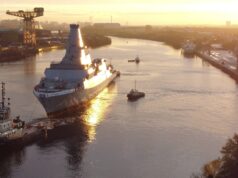
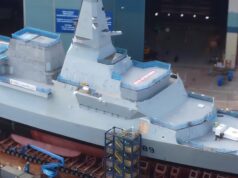
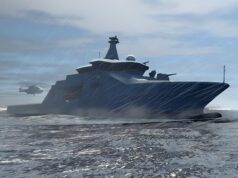
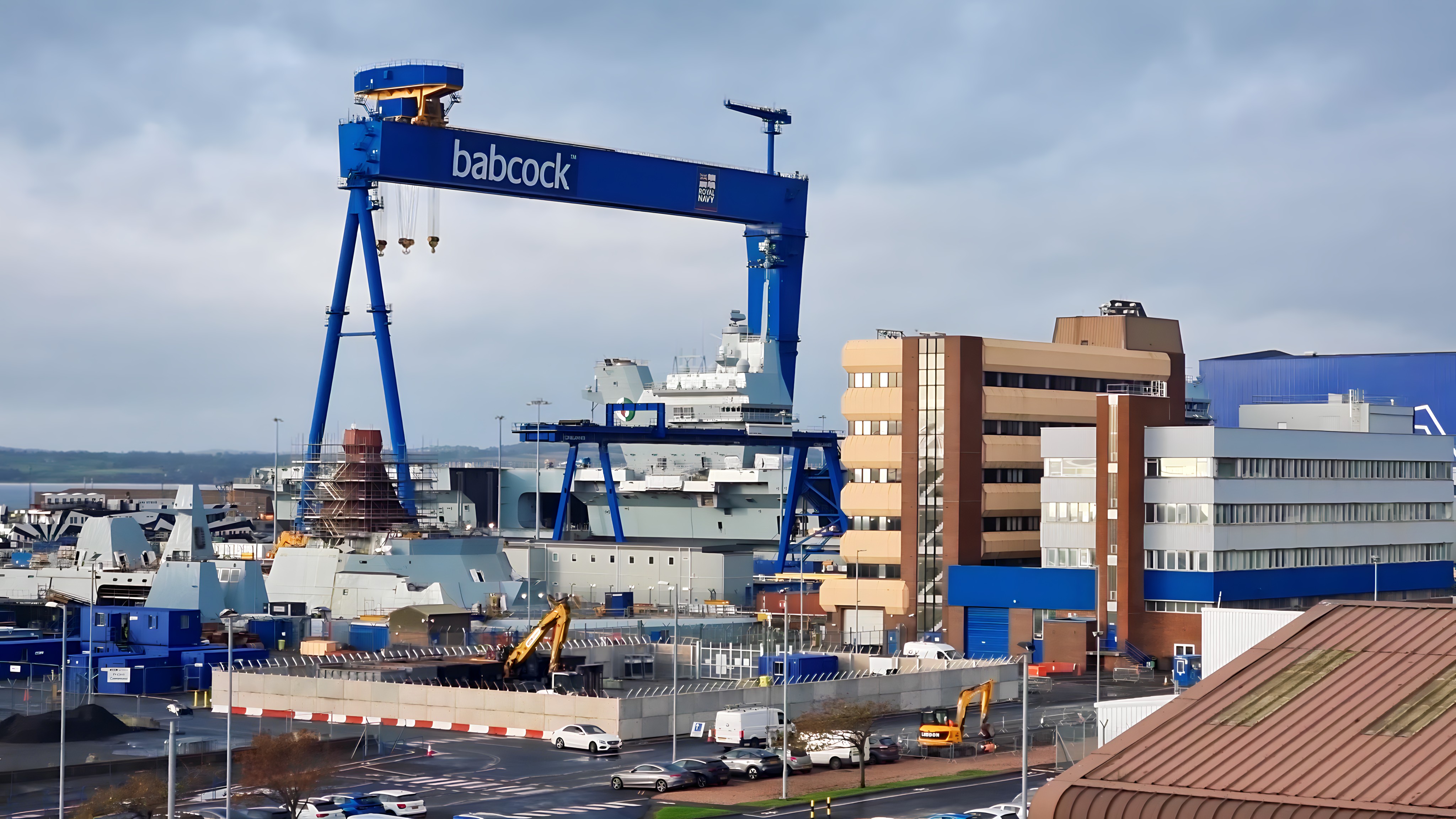

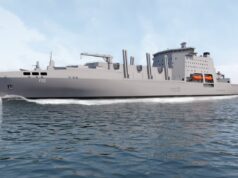

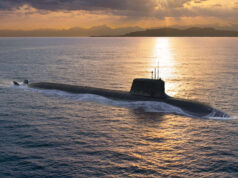
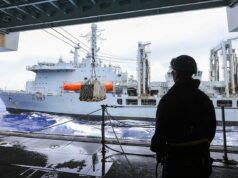
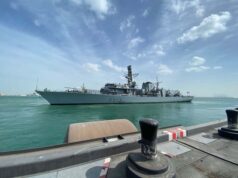

Good news. Here’s hoping this is the end of the issues.
At sea is a bit of a stretch, she’s not even the other side of the bridges yet, the water is barely salty. 😉
Great to see her back in service
If you want to see her on a live Cam just search “theforthbridges.com”it’s a panoramic shot but look behind the Queensferry bridge 3rd supporting column from the left or just in the middle between the shore and suspension cables. She’s just skulking behind it with the tops of the superstructures just above the roadway and hull just below it.
In honour of Queen Elizabeth 1…don’t you mean Queen Elizabeth 11…!!!
She is actually named after our Tudor Queen, Elizabeth I. The Ship’s Crest depicts the Tudor Rose.. https://www.fleetairarmoa.org/content/sites/faaoa/uploads/NewsImages/1508/HNS_Queen_Elizabeth_crest_large.jpg… And, read this article from UK Defence Journal on the origins of the name.. https://ukdefencejournal.org.uk/royal-navy-press-team-confirm-monarch-hms-queen-elizabeth-named/
Elizabeth the first. Is it made out of wood
Great to see the Two best aircraft carriers back in operation, yes they have had teething problems, which is completely normal for such large & complex ships, if you take for example the USNs Gerald R Ford, she has been riddled with problems/ faults, especially with her EMLA systems, when the French carrier Charles De Gaulle left port one of her propellers quite literally fell off and sank to the bottom of the sea, which i believed is still there to this day. The Two Queen Elizabeth class Aircraft Carriers are the only carriers in existence which are purpose built from scratch to accommodate/ Operate the superb F35 (B) my one concern is that they may lack defensive armaments??
There are 2 sides to that question mate.
They have their CIWS, ESSM, and other sneaky EW bits.
Then you could also say they’re the best defended Airfields we have with T23s, T45s escorting them. And of course the F35s too.
They don’t have ESSM , they have no point missile defence and the only carriers not to have them . 2 -t45 at best means 96 missiles for air defence . Let’s not get carried away mate . Paveway bombs are what our f35s drop .
Hello mate, always good to hear from you, whilst your here, apparently there is some talk about the cancellation of our next generation jet, ((Tempest), if this program does get the chop, any idea of what we could end up with instead (F35A??)
If Tempest is canceled F35A has always been the fall back plan. It’s one of the reasons the government never alters the 138 buy number.
At this current time,Tempest is going ahead, there is no talk about cancelling it, just speculation from the Telegraph. Tempest is a 6th gen aircraft being jointly designed with Japan and Italy without this aircraft, all 3 countries will be left behind in the 6th gen tech and capability leap.
F35A is 5th gen and most definitely not the “fall back plan”.
If it was F35 for the fall back it’s more like to be an F35D as a 5.5 Gen aircraft with adaptive cycle engine with possible manufacture at Wharton.
But I agree it’s a shitty option, we need Tempest.
Agreed, Tempest is the right direction in so many ways. For a start it keeps the UK at the very leading edge of aircraft technology and capability. Who knows what will happen though given our history of cancellations and dithering.
Rumour spread I think by the DT as B says.
I still find it interesting that Trident and AUKUS are assured pre review yet Tempest is not, given it’s equal importance.
So saying it’s not confirmed because the review hasn’t happened yet seems odd to me.
F35A mate. There is no money for it and F35B, but if Tempest goes we would probably get some.
The historical own goal, especially re Japan, would be unbelievable, yet going by HMG standards possible.
I’m just hoping that we don’t cancel it as it would be a killer blow to UK aircraft design and build capability, a big mistake in my opinion.
We should be doing this and actively seeking sales in other countries. It’s not just the cost to us, it’s the Jobs,revenue and knowledge that adds the greatest value. ✈
Yes.
As long as people remember if we are putting tech, industry, jobs and knowledge at the forefront that’s many billions less on other things, like the numbers everyone moans about.
You cannot have it all.
I’ve always suggested a balance is needed between quality and quantity as we lack the mass we need.
Does anyone serioulsy believe Tempest will match Typhoon numbers? I don’t.
Not even sure with the loyal wingman types.
I get what you say totally but we must stay in the military aircraft business otherwise we lose the capability and have to resort to buying American or Franco German.
It’s a smaller market place than Typhoon most definitely but get others interested and who knows what might happen.UK, Japan, Italy, Saudi Arabia, Qatar, South Korea, Poland, Spain, Turkey hell even India and Germany might just be potential customers.
Only time will tell I guess.
I’m sure we will debate this for many years to come. 🕘
Oh and I forgot Australia and Canada, maybe I’m wrong but everything is possible.
I worry with transfer of tech like Tempest how soon it ends up in Russian and Chinese laps with too many sales.
Turkey India Qatar S Arabia no thank you.
European NATO, the anglosphere, Japan, S Korea ok.
Just examples of possible buyers in reply to your comment about Typhoon levels. Personally I’m uncomfortable with Turkey, India, and Saudi Arabia but sort of OK with Qatar.
So you ok with the sponsors of hamas?
They buy fighter jets anyway…
If we hadn’t sold them Typhoon then Warton would’ve closed and they would’ve just bought more Rafales.
It’s the opposite of sponsoring Hamas anyway as it’s taking money away from Qatar.
and off course US F15s as well
Take it up with the Foreign office, let us know their reply.
Unsure about India, unless thy start putting some real distance between themselves and Russia.
I’m talking about possible sales not partnerships/work share. I’m just putting forward possible buyers as that’s where the money is just like F35.
India messed around with Typhoon, Saudi Arabia has a long history of buying stuff from us. Qatar has purchased 24 Typhoons and we work closely with them.
We once sold aircraft all over the world in large quantities, it’s good business.
Hi Baker, I understand your point, don’t disagree . My concern is tech leaks to Russia. I cant see the India being able to guarantee it wont happen.
That being said I imagine at some point the Russians(and Chinese) would get their hands on the tech, one way or another.
Agreed DM. –Turkey India Qatar S Arabia no thank you.
Hi M8,
Glad someone mentioned numbers, it’s the bit that really worries me and anyone with a Brain cell would look at what Europe is doing and just say WT* are we doing !
We have 2 multi national groupings presently trying to develop broadly similar twin engined, high end 6 generation Uber Fighters. Its industrial self harming on a massive and very public scale.
The vast majority of NATO countries are relatively small and will never be able to afford to buy many or even any.
IMHO The 2 ground needs to coordinate under a common industrial agreement, maximise equipment fit across both groupings and agree to develop 2 different 6th Generation aircraft.
A high end twin engine Uber Fighter and a single engine smaller light weight Fighter to cater for a High / Low mix but also to maximise overall mass.
Use the same engine, cockpit, radar, aeronautics as possible in both but ensure the maximum ability to integrate different weapon systems.
There are 3 European Countries and Japan who have all designed and built combat fighters and between them they should lead the design teams in 2 partnering agreements. UK/Japan and France/Sweden backed by Germany, Spain, Italy and Poland.
Otherwise we end up spending a fortune to end up with a very limited number of 2 very expensive mutually exclusive assets.
All sensible mate.
Interestingly the rumour was also picked up by the Times yesterday, I haven’t looked at Sundays yet. We all know it would be a ridiculous decision on several levels but that has never stopped hmg before.
I’m probably wrong, but I can’t help thinking the UK’s & Japan’s armed forces are rather similar, I think the Japanese navy have looked to our RN as a base model ( so to speak) their attack on pearl Harbour was apparently a copy of the RNs preemptive attack on the Italian fleet, learn from the best!!!
Their escort and MPA fleet dwarfs ours now.
We have the pricey strategic assets like SSN and large Carriers.
Japan and Great Britain have a very long history of cooperation militarily, just look at their WW1 Battleships.
Like many other countries we had a temporary period of Military cooperation with Japan. France & Germany both had various periods of influence during Japans Military / Industrial modernisation. When Japan became self sufficient in armaments post 1921 it came to a grinding complete halt and volte face. It was always far more of a commercial arrangement than Government to Government which is why their Battleships were based on Vickers designs or RN clones. Funnily enough their Destroyers were based on German designs.
Where there was a legacy was in their Naval Architects who were mainly all RCNC trained and there were some design points in post 1921 Battleships and Carriers that were gleaned from that background and contacts. The early Hiraga designs for what became the Yamato Battleships had a very similar armour system to the G3 designs.
Something less is my guess it’s never more…..
Afternoon DeeBee, with you on this. Even an incremental up gunning, not even talking missiles. Looking at this photo, I’m not even sure the carriers are even covered straight on so I feel the starboard Phalanx could be brought forward onto the deck where the GPMG post is, add another Phalanx at the rear and two 40mm, one starboard and port. My 5p worth. Others have even suggested just 4 x 40mm. And some Ancilia or other decoy launchers for extra protection especially anti torpedo would surely be worth it for these carriers? I have no knowledge of ECM the carriers carry so let others comment on that.
All other NATO, Russian, Chinese carriers have SAMs. In fact the QE class was originally to have Aster 15. So the QE class is under armed by world standards. This is entirely due to penny pinching. Other nations have the right idea and protect their investment. In my view the ships should be fitted with Sea Ceptor, the Phalanx replaced with 40mm mounts and the extra one at the stern added. This would bring it to RARITY with other NATO carriers.
Hi Rob, out of curiosity do you know how many vls and where the Aster silos would have been placed around the carrier as there’s the concern over FOD?
Lol I think it already is a “rarity”…I think you mean “parity”! 🤣
Why 40mm, surely a couple of 16 inch guns would be better 😀
You know Phalanx is deck mounted right?
What 40mm system are you talking an about? BAE?
Its deck penetrating so your looking at a full rebuild on the ship to add a very marginal gun capability.
Can be not deck penetrating but with reduced capacity but still let’s add that in plus a some sea ceptor massively reduced fod especially if it is at aft
Jim other than Russia and Japan nearly every gun or missile mounted in a carrier is in or on a sponson so you just enlarge, alter or add them. A VLS is deck penetrating.
If the carrier needs all that to defend herself then all the other layers have been neutralised. T45, T23, F35, Asstoot, Merlin, Wildcat, not to mention other NATO assets.
Look at what’s left of the Russian Navy in the Black Sea, no-one saw that coming not least of all the Russians on the Moskva with all it’s missiles and CWIS.
Which where either turned off or defective.
Dont compare the orcs to the RN. The RN learnt lots of hard lessons post 82 , applied them, learnt from them and improved on them. It still does.
Ok …where are you putting CAMM? Ignoring the missiles which are a separate and length discussion on weapon and magazine safety in themselves…
Data link aerials are going where? Somewhere where they are not wooded and don’t suffer from mutual interference or affect other systems with their transmissions. Ideally data links go high up but on a carrier that’s a none starter due to lack of deck space on the islands.
Mutual interference is an issue for all sensor systems that transmit. Working around it involves timed blanking pulses and strict frequency control not just on the ship itself but across other task group units. Get it wrong and you lose radar displays due to interference. Using the same missile control frequencies on all units in a task group is a sure fire way of making missiles going rogue.
You also need to consider the aircraft. Are they and their systems especially weapons affected by transmissions? Do transmissions from the aircraft affect ships systems. Most aircraft are now composite and are a lot more transparent to RF than a steel ship is.
There are plenty of cases around where a transmission on a ship has resulted in aircraft on deck and weapons doing things they shouldn’t have.
Off the top of my head from my system engineering and ShipHaz courses:-
USS Forestal Fire- Spurious electrical signal probably caused by RF set off a rocket on an aircraft. It launched, hit a fuel tank and the fires killed 134 people.
Buccaneer Undercarriage closed when on deck. Caused by spurious RF signal breaking through into the aircrafts control systems.
There are others I know about where people and ships got very, very lucky that incidents didn’t snowball out of control.
3 phalanx give hemispherical coverage over 360 degs of arc.
All 3 mounts link and “talk” to each other to determine the highest threat and to allocate the best placed system to engage it. All this is real time and automatic. No “man in the loop”. The threat evaluation and weapon assessment (TEWA) table stops 2 mounts going for the same target.
Ships move .
So you open up firing arcs to provide your best chance of getting a hit down a threat axis.
Bring in 40mm and you need a surveillance radar, track extractors, operators, command system, EO/Radar directors, TEWA, it adds complexity and gives lots of single points of failure.
Torpedo 2170 is fitted as required dependent on the threat area you are going to. No need for it doing jollies around the UK or to the states. On a deployment you will get it.
GB, thanks, great reply. I understand the 360 degree hemispherical coverage but I’m wondering if one Phalanx falls over, breaks down, out of ammo, the two remaining wouldn’t offer sufficient coverage in a sustained missile/drone attack and that an addition of a fourth Phalanx would mitigate that? I’d even like to see a SeaRam pairing with the Phalanx’s, positioned out of the way to minimise FOD.
Wouldn’t even having a pair of 40mm give an extra depth of protection out to 2-5+ km and be quite easy to integrate and replenish?
Thanks for the feedback on the anti-torpedo defences but it would be nice to see a few Ancilia mounts on these Carriers too as they’re going to be on the T45, T26 and T31s. Better to be over protected these days I think. Can you imagine the CSG transiting the Suez Gulf at the moment? Although there would be F35Bs and hopefully some land attack missiles at their disposal it’s throwing expensive good stuff after bad, and they’re not going away fast.
If a phalanx goes down the tewa table continues and the mounts that are left work out between themselves which one goes for what.
Regarding decoys…they may get them but its a huffing big radar and IR target. No matter what you throw up , chaff, active decoys , IR, its going to need a really dumb missile to not go for it, hence escorts dealing with threats way down range.
I am looking out of my office right now at an LCS with a Sea Ram mount fitted. 11 shots. Thats all it has. Its IR guided. As has already been seen in Ukr ivan has been fitting flare dispensers to cruise missiles to decoy IR missiles. As the seaker head is derived from a stinger its already a known quantity. If you need to salvo it at a target then you have 5 shots at targets if you are luck.
Again use your escorts to engage down range is a way better idea.
I understand where you’re coming from. But what if the UK could utilise a SeaRam type mount but with Starstreak/LMM (ER version would be useful) or ASRAAM? 11 of each x two mounts linked into the Phalanx network? It’s a fantasy but the SeaStreak CIWS was put forward ages ago and look how successful SeaRam and RAM had been.
Do we know what upgrades were made?
There was talk that the ships were unable to take full advantage of the F35s MADL due to bandwidth limitations. Anyone know if this issue was resolved?
RN may be leery of providing specific details re upgrades. Public statements have been made recently by the RN that it intends to leverage maintenance periods to insert upgrades to the maximum feasibile extent. Once again the blokes down at the Admiralty are exercising those brain cells. 😁👍
When QEC was specified the network was 10Mb/s. I suspect this is what you are talking about.
There was an announcement quite a while back about changing the core network to fibre. And I *think* this was done already from titbits I’ve seen in announcements.
Changing the bits of network that run a CCTV camera is probably a total waste of time. Other bits that monitor machinery are at such a low bit rate that upgrading bandwidth serves no function at all.
Potentially good news then.
Being able to make full use of the aircraft’s capabilities makes total sense.
The physical internal network carriers on QE and POW are based on blown fibre networks. Individual fibres are literally blown down a pipe using compressed air during installation to where they are needed. You then connect the fibre to the network. The capacity is huge for data transmission.
The issue doesn’t lie with the fibres it lies with the bits of kit on the ends of the fibres.
I know the core network was fibre – always is for EMC – no signature from fibre.
I don’t think the peripheral network is blown fibre.
As you say it is an issue of upgrading the optical -> Ethernet modules and routers.
Gigabit ethernet arrived in 1999 (following on from 100 Mbs), I don’t think there is any possibility whatsoever of widespread use of 10Mbs ethernet on a ship that wasn’t even laid down until 2009.
I’m well aware of that.
The issue is when things are specified and designed. This is fundamentally a 1990’s design.
In things military you are often using previous generations of parts and technologies simply because they are tested and certified at point of design freeze. If you don’t have design freeze then cost control is out of the window.
I’d be surprised if the core network hadn’t been upgraded shortly after acceptance.
It is well known that on QEC the network was under specified at point of build.
I think this was sorted on PoW.
I used to sell computer systems and networks into Government departments, including the MoD so I am also well aware of the issues regarding military procurement, but the gap between 10 Mbs being even vaguely the standard is so huge in this instance I still find it hard to believe.
On a fighting platform it has to be EMC, EMP, EME & shock tested. So legacy modules tend to be used to longer than makes rational sense unless there is a clear need to evolve them.
At that point in time computers didn’t have SSD’s so throughput was pretty limited on a non core network. Generally the disk, in a PC, was the limiting factor.
Come 2014(ish) and the widespread adoption of SSD’s then, of course, that changes dramatically.
I’d separate all of this discussion from the core network that will, presumably, have run at gigabit.
Sorry my memory had removed a zero at some point.
“2.4 Common Network
The IPMS uses a third party supplied network consisting of a Blown Fibre Optic Plant (BFOCP) and
Internal Network Electronics (INE) to provide interconnectivity across the Platform. The BFOCP
provides physically protected microducts in which fibre is blown. INE switching is provided at
equipment and at individual Node Rooms. The IPMS real time network is an Ethernet/IP network
running at 100Mbs below Node Room and 1Gbts between nodes.”
It is rather oddly a public domain document……
That makes a lot more sense
Welcome back into service QE & well done the crew & all those working on getting her back ready for service.
These are vital parts of “the “big stick” as in “talk quietly but carry a big stick”.
All we need now is a few more fingers(escorts, FSS & F35s) on the hand holding the “big stick”.
I think I read that work on the propeller shafts went a lot further than a repair to the starboard propeller shaft coupling. I think they may have installed two redesigned shafts based on experience with PoW, ie a much more robust solution. But as ever, happy to stand corrected.
As ever, the cost of the parts and time is weighted up against the dry docking costs and the risks of operation failure of a key asset.
It is likely that if there was a fault both shafts were fixed at the same time.
Good Evening , at last H.M .R.N Flagship is underway, supposedly one of our most powerful warships , slightly overpriced,over stated as to her capability which excuse me for stating the ‘Blinking obvious ‘neither of them H.M.P.W have a full compliment of aircraft (unless you count our American friends)who l personally suspect are ‘saying can they step up to the mark ,pull their weight ect )now it’s important to state here and now that it’s not question the professional capability,of our piolts and their abilities in upholding the values that their forefathers gave in ‘Spades’by their unerving,self sacrifice for the better of their fellow man , as always I remain totally loyal to my “Oath too My Country/Family and to H.M (upholding the the best values of our Nation)/The Golden Thread .
Saw Queen Elizabeth about 9pm tonight near the 3 bridges wait for high tide at 01.45am to sail away, she looked great waiting to return to duty
Offcourse you will have noticed how our American friends continue to operate Harrier even after it’s suppose to be retired and most of their carriers can’t operate the small number of F35C’s they have.
Slow role out of F35 is affecting everyone. We also allowed USMC to take our early production slots because they needed them more in return they leant us a squadron.
Queen Elizabeth class is the only super carrier that’s demonstrated the ability for allied squadrons to be imbedded in the air group. This makes it even more useful.
The UK is a small country pulling way more than its weight and no one in Washington is lecturing anyone from the UK on international responsibility.
Exactly. The QE’s were designed to operate F35, its a 5thgeneration warship. Harrier is a small aircraft and sits much better on the U.S assault ships. Myself, I used to think that the QE’s were much too big, but having read around the issue it seems they are the right size. Even operating ‘only,’ 24 or so is comfortable, there is room to manoeuvre aircraft and choppers, they can carry adequate support facilities. The weapon handling equipment is apparently slick, and a high tempo of operations is not hampered by cramped space. Less is more when it comes to generating sorties ( rubbish really, i want LOADS on there).
Seeing the big American Assault ships as substitute ‘carrier’s’ is very misleading from what I have read, and the Harrier is yesterdays tech. Yes, carrying a few F35 may be useful but not a substitute for a Queen.
I believe, and can stand being corrected, that the USMC has more F35 that can be accommodated on the assault ships. Why would they not want them to bump up the total on a QE in time of need…in fact, these aircraft would be more useful on a QE rather than an assault ship…or the Japanese
.etc etc
AA
According to Wiki (I know) The US Navy is planning on getting 260 F35Cs. The USMC is planning on buying 80 F35Cs in addition to the purchase of 340 F35Bs.
That’s a s***load F35Bs if I may say so!
“The vessel completed a round-the world-deployment in 2021” Well not really but still a long way.
Round the world next time. Pull in at Buenos Aires. 😉
You’re a wicked man 😂
F-35 numbers, Crowsnest and propshafts are all starting to look like rear view mirror hiccoughs in the delivery of a very successful program. It looks like the RN is planning for MRSS to be something nearer to San Antonio class than Bay class. If so we are looking at a very substantial expeditionary capability.
I would like to know why HMS QUEEN ELIZABETH was given the pennant number RO8 when this belonged to HMS BULWARK of the 60s and 70s. All the history of RO8 belongs to HMS BULWARK. Why not give HMS QUEEN ELIZABETH the next vacant RO number?
I’m ex RN with IS A and RNR CPOSA. Welcome any old shipmates to my email
Has two potential Achilles heels: the need to refuel every 10 days, has no defence capability itself- entirely dependent on the carrier strike group. How quickly can such forces adapt to new weapon threats from the hypersonic to sea drones?
“the need to refuel every 10 days”-like 95+ of all warships & every carrier we’ve ever operated. It’s perfectly normal & very few navies operate nuclear powered surface ships. Thankfully the one arm of replenishment we’ve nailed is fleet tankers, the Tide & Wave classes. The big nuclear powered carriers also need to replenish aviation fuel amongst over things, so it’s not the magic solution as much as it seems, being nuclear powered. No nuclear powered aircraft, yet.
Besides I’m thinking of a war where several nuke powered large vessels end up on the sea bed. How’s that going to affect the food chain or even the water cycle safety?
Anyone know if she’s going directly to Pompey & when she might be due if so?
Why is it that whenever the carriers go into port for any sort of work they spend money to remove the Phalanx CIWS and then spend more money to put them back on again…
Can they not just accept they are part of the ships kit and leave them alone. Or even put the missing fourth one on.